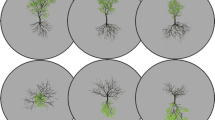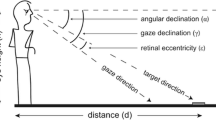Abstract
We investigated the influence of gaze elevation on judging the possibility of passing under high obstacles during pitch body tilts, while stationary, in absence of allocentric cues. Specifically, we aimed at studying the influence of egocentric references upon geocentric judgements. Seated subjects, orientated at various body orientations, were asked to perceptually estimate the possibility of passing under a projected horizontal line while keeping their gaze on a fixation target and imagining a horizontal body displacement. The results showed a global overestimation of the possibility of passing under the line, and confirmed the influence of body orientation reported by Bringoux et al. (Exp Brain Res 185(4):673–680, 2008). More strikingly, a linear influence of gaze elevation was found on perceptual estimates. Precisely, downward eye elevation yielded increased overestimations, and conversely upward gaze elevation yielded decreased overestimations. Furthermore, body and gaze orientation effects were independent and combined additively to yield a global egocentric influence with a weight of 45 and 54%, respectively. Overall, our data suggest that multiple egocentric references can jointly affect the estimated possibility of passing under high obstacles. These results are discussed in terms of “interpenetrability” between geocentric and egocentric reference frames and clearly demonstrate that gaze elevation is involved, as body orientation, in geocentric spatial localization.




Similar content being viewed by others
References
Becker W, Jürgens R, Boß T (2000) Vestibular perception of self-rotation in different postures: a comparison between sitting and standing subjects. Exp Brain Res 131(4):468–476
Benson AJ (1990) Sensory functions and limitations of the vestibular system. In: Warren R, Wertheim AH (eds) Perception and control of self-motion. Erlbaum, Hillsdale, pp 145–170
Bertelson P, Radeau M (1981) Cross-modal bias and perceptual fusion with auditory-visual discordance. Percept Psychophys 29(6):578–584
Bishof N (1974) Optic-vestibular orientation to the vertical. In: Kornhuber HH (ed) Handbook of sensory physiology, vestibular system part 2: psychophysics, applied aspects and general interpretations, vol 6. Springer, New York, pp 155–190
Bock O (1993) Localization of objects in the peripheral visual field. Behav Brain Res 56:77–84
Bortolami SB, Pierobon A, DiZio P, Lackner JR (2006) Localization of the subjective vertical during roll, pitch, and recumbent yaw body tilt. Exp Brain Res 173(3):364–373
Braithwaite MG, Douglass PK, Durnford SJ, Lucas G (1998) The hazard of spatial disorientation during helicopter flight using night vision devices. Aviat Space Environ Med 69(11):1038–1044
Bringoux L, Tamura K, Faldon M, Gresty MA, Bronstein AM (2004) Influence of whole-body pitch tilt and kinesthetic cues on the perceived gravity-referenced eye level. Exp Brain Res 155(3):385–392
Bringoux L, Mezey LE, Faldon M, Gresty MA, Bronstein AM (2007) Influence of pitch tilts on the perception of gravity-referenced eye level in labyrinthine defective subjects. Neuropsychologia 45(2):350–356
Bringoux L, Robic G, Gauthier GM, Vercher JL (2008) Judging beforehand the possibility of passing under obstacles without motion: the influence of egocentric and geocentric frames of reference. Exp Brain Res 185(4):673–680
Coello Y, Iwanow O (2006) Effect of structuring the workspace on cognitive and sensorimotor distance estimation: no dissociation between perception and action. Percept Psychophys 68(2):278–289
DiLorenzo JR, Rock I (1982) The rod-and-frame effect as a function of the righting of the frame. J Exp Psychol Hum Percept Perform 8(4):536–546
Flanders M, Soechting JF (1995) Frames of reference for hand orientation. J Cogn Neurosci 7(2):182–195
Galati G, Lobel E, Vallard G, Berthoz A, Pizzamiglio L, Le Bihan D (2000) The neural basis of egocentric and allocentric coding of space in human: a functional magnetic resonance study. Exp Brain Res 133(2):156–164
Ghafouri M, Archambault PS, Adamovich SV, Feldman AG (2002) Pointing movements may be produced in different frames of reference depending on the task demand. Brain Res 929(1):117–128
Gibson JJ (1979) The ecological approach to visual perception. Houghton Mifflin, Boston
Goldberg JM, Fernandez C (1977) Conduction times and background discharge of vestibular afferents. Brain Res 122(3):545–550
Goodenough DR, Cox PW, Sigman E, Strawderman WE (1985) A cognitive-style conception of the field-dependence dimension. Cah Psychol Cogn 5:687–706
Guerraz M, Poquin D, Luyat M, Ohlmann T (1998) Head orientation involvement in assessment of the subjective vertical during whole body tilt. Percept Mot Skills 87(2):643–648
Howard IP (1982) Human visual orientation. Willey, New York
Ito Y, Gresty MA (1997) Subjective postural orientation and visual vertical during slow pitch tilt for the seated human subject. Aviat Space Environ Med 68(1):3–12
Kappers AML (2003) Large systematic deviations in a bimanual parallelity task: further analysis of contributing factors. Acta Psychol 114(2):131–145
Kappers AML (2004) The contributions of egocentric and allocentric reference frames in haptic spatial tasks. Acta Psychol 117(3):333–340
Kirkham WR, Collins WE, Grape PM, Simpson JM, Wallace TF (1978) Spatial disorientation in general aviation accidents. Aviat Space Environ Med 49(9):1080–1086
Li W, Dallal N, Matin L (2001) Influences of visual pitch and visual yaw on visually perceived eye level (VPEL) and straight ahead (VPSA) for erect and rolled-to-horizontal observers. Vision Res 41(22):2873–2894
MacDougall R (1903) The subjective horizon. Psychol Rev 4:145–166
Marcilly R, Luyat M (2008) The role of eye height in judgment of an affordance of passage under a barrier. Curr Psychol Lett 24(1):12–24
Mark LS (1987) Eyeheight-scaled information about affordances: a study of sitting and stair climbing. J Exp Psychol Hum Percept Perform 13(3):361–370
Mars F, Vercher JL, Blouin J (2004) Perception of the vertical with a head-mounted visual frame during head tilt. Ergonomics 47:1116–1130
Mars F, Bringoux L, Cian C, Barraud PA, Raphel C, Vercher JL (2005) Perception de la verticale avec un cadre visuel solidaire de la tête : implications pour l’utilisation des visiocasques. Trav Hum 68:125–152
Matin L, Li W (1992) Visually perceived eye level: changes induced by a pitched from—vertical 2-line visual field. J Exp Psychol Hum Percept Perform 18(1):257–289
Matin L, Li W (1995) Multimodal basis for egocentric spatial localization and orientation. J Vestib Res 5(6):499–518
McIntyre J, Stratta F, Lacquaniti F (1997) Viewer-centered frame of reference for pointing to memorized targets in three-dimensional space. J Neurophysiol 78(3):1601–1618
Mittelstaedt H (1983) A new solution to the problem of the subjective vertical. Naturwissenschaften 70(6):272–281
Mittelstaedt H (1986) The subjective vertical as a function of visual and extraretinal cues. Acta Psychol 63:63–85
Neggers SFW, Schölvinck ML, van der Lubbe RHJ, Postma A (2005) Quantifying the interactions between allo- and egocentric representations of space. Acta Psychol (Amst) 118(1–2):25–45
Ooi TL, Wu B, He ZJ (2001) Distance determined by the angular declination below the horizon. Nature 414:197–200
Paillard J (1991) Motor and representational framing of space. In: Paillard J (ed) Brain and space. Oxford University Press, Oxford, pp 163–182
Pick HL, Warren DH, Hay JC (1969) Sensory conflict in judgment of spatial direction. Percept Psychophys 6:203–205
Poljac E, Lankheet MJM, van den Berg AV (2005) Perceptual compensation for eye torsion. Vision Res 45(4):485–496
Poljac E, van den Berg AV (2005) Localization of the plane of regard in space. Exp Brain Res 163(4):457–467
Posner MI, Snyder CRR, Davidson BJ (1980) Attention and detection of signals. J Exp Psychol Gen 102(2):160–174
Raphel C, Barraud PA (1994) Perceptual thresholds of radial accelerations as indicated by visually perceived eye level. Aviat Space 65:204–208
Roumes C, Grau JY (2003) Rafale: a human factors view of the man machine interface. Med Aeronaut Spat 45:23–26
Rosenhal U (1972) Vestibular macular mapping in man. Ann Otol Rhnol Laryngol 81:339–351
Sharp WL (1934) An experimental study concerning visual localisation in the horizontal plane. J Exp Psychol (Hum Percept) 17:787–797
Soechting JF, Flanders M (1992) Moving in three-dimensional space: frames of reference, vectors, and coordinate systems. Annu Rev Neurosci 15:167–191
Stoper AE, Cohen MM (1986) Judgements of eye level in light and in darkness. Percept Psychophys 40:311–316
Stoper AE, Cohen MM (1989) Effect of structured visual environments on apparent eye level. Percept Psychophys 46(5):469–475
Van der Meer ALH (1997) Visual guidance of passing under a barrier. Early Dev Parent 6:149–157
Wagman JB, Malek EA (2008) Perception of whether an object affords walking under from different points of observation. Ecol Psychol 20:65–83
Warren DH (1979) Spatial localization under conflict conditions: is there a single explanation? Perception 8:323–337
Warren WH Jr (1984) Perceiving affordances: visual guidance of stair climbing. J Exp Psychol Hum Percept Perform 10(5):683–703
Warren WH Jr, Whang S (1987) Visual guidance of walking through apertures: body-scaled information for affordances. J Exp Psychol Hum Percept Perform 13(3):371–383
Zoccolotti P, Antonucci G, Goodenough DR, Pizzamiglio L, Spinelli D (1992) The role of frame size on vertical and horizontal observers in the rod-and-frame illusion. Acta Psychol 9(2):171–187
Acknowledgments
Aurore Bourrelly was supported by a grant from DGA-CNRS (No. 2007-746). The authors are grateful to Gabriel Gauthier, Franck Buloup, and Alain Donneaud for their technical expertise and Cecile Scotto for her help during data acquisition and processing. They also thank Thelma Coyle, Julie Martin-Malivel and George Mitchell for English corrections, and the anonymous reviewers for their helpful comments in revising the current manuscript.
Author information
Authors and Affiliations
Corresponding author
Rights and permissions
About this article
Cite this article
Bourrelly, A., Bringoux, L. & Vercher, JL. Influence of gaze elevation on estimating the possibility of passing under high obstacles during body tilt. Exp Brain Res 193, 19–28 (2009). https://doi.org/10.1007/s00221-008-1589-0
Received:
Accepted:
Published:
Issue Date:
DOI: https://doi.org/10.1007/s00221-008-1589-0




